AGRICULTURAL SCIENCES PAPER 1 GRADE 12 QUESTIONS - NSC EXAMS PAST PAPERS AND MEMOS NOVEMBER 2018
Share via Whatsapp Join our WhatsApp Group Join our Telegram GroupAGRICULTURAL SCIENCES
PAPER 1
GRADE 12
NSC EXAMS
PAST PAPERS AND MEMOS
NOVEMBER 2018
INSTRUCTIONS AND INFORMATION
- This question paper consists of TWO sections, namely SECTION A and SECTION B.
- Answer ALL the questions in the ANSWER BOOK.
- Start EACH question on a NEW page.
- Number the answers correctly according to the numbering system used in this question paper.
- You may use a non-programmable calculator.
- Show ALL calculations, including formulae, where applicable.
- Write neatly and legibly.
QUESTIONS
SECTION A
QUESTION 1
1.1 Various options are provided as possible answers to the following questions. Choose the answer and write only the letter (A–D) next to the question numbers (1.1.1 to 1.1.10) in the ANSWER BOOK, e.g. 1.1.11 B.
1.1.1 The first three compartments of a ruminant stomach:
- Rumen complex
- Forestomach
- Abomasum
- Digestive system
1.1.2 Volatile fatty acids that are end products of rumen microbial fermentation include … acids.
- methanoic and butyric
- acetic and propionic
- acetic and ethanoic
- methanoic and ethanoic
1.1.3 An example of a protein-rich concentrate:
- Oats meal
- Sorghum meal
- Fish meal
- Maize meal
1.1.4 During the active absorption of food …
- CO2 and methane move along the concentration gradient.
- the energy needed is supplied by ATP.
- molecules move from a higher to a lower concentration.
- glucose and amino acids are absorbed along the concentration gradient.
1.1.5 The best explanation of external parasites on cattle:
(i) Live on the skin
(ii) Can damage the skin
(iii) Can produce toxins
(iv) Can damage the liver
Choose the CORRECT combination:
- (i), (iii) and (iv)
- (ii), (iii) and (iv)
- (i), (ii) and (iii)
- (i), (ii) and (iv)
1.1.6 Equipment that a beef farmer needs to determine the average daily gain:
- Electric prodder
- Neck clamp
- Feeding trough
- Electronic weighing scale
1.1.7 The following regarding a feedlot production enterprise are TRUE:
- Provides shade and shelter to animals
- Harvests pastures to provide feed for the animals
- Practises rotational grazing
- Labour and capital intensive
Choose the CORRECT combination:
- (i), (iii) and (iv)
- (ii), (iii) and (iv)
- (i), (ii) and (iii)
- (i), (ii) and (iv)
1.1.8 Which ONE of the following should NOT be done when handling chickens?
- Grab the chicken by the tail or wings.
- Use one hand to support the chicken from underneath.
- Position the chicken under the arm for examination.
- Grab the chicken by its feet.
1.1.9 The path that milk follows in the udder until it is released from the teats:
- Alveoli → milk tube → gland cavity → teat cavity
- Alveoli → gland cavity → milk tube → teat cavity
- Milk tube → alveoli → gland cavity → teat cavity
- Gland cavity → alveoli → milk tube → teat cavity
1.1.10 Oogenesis in female animals takes place in the …
- spermatogonium.
- corpus luteum.
- oviduct.
- ovary. (10 x 2) (20)
1.2 Indicate whether each of the descriptions in COLUMN B applies to A ONLY, B ONLY, BOTH A AND B or NONE of the items in COLUMN A. Write A only, B only, both A and B or none next to the question numbers (1.2.1 to 1.2.5) in the ANSWER BOOK, e.g. 1.2.6 B only.
COLUMN A | COLUMN B | ||
1.2.1 | A: | Ideal protein | All the proteins ingested, absorbed and incorporated to provide all the essential amino acids in correct amounts and proportion to the body |
B: | Incomplete protein | ||
1.2.2 | A: | Vitamin A | A deficiency may cause delayed clotting of blood |
B: | Vitamin D | ||
1.2.3 | A: | Intradermal | Injecting animals between the layers of the skin |
B: | Subcutaneous | ||
1.2.4 | A: | Deep-litter system | Intensive production system where chickens are kept in a house throughout their lives |
B : | Battery system | ||
1.2.5 | A: | Condition | The forelegs and nose of the foetus point towards the pelvis with the head resting on its forelegs during parturition (5 x 2) (10) |
B : | Presentation | ||
1.3 Give ONE word/term for EACH of the following descriptions. Write only the word/term next to the question numbers (1.3.1 to 1.3.5) in the ANSWER BOOK.
1.3.1 A deficiency symptom in pigs caused by a lack of zinc which results in skin lesions and hair loss
1.3.2 Equipment fitted with a water valve and a nozzle used to supply water to the sow and piglets
1.3.3 A powerful contraction of the urethra through which semen is deposited into the vagina of a cow
1.3.4 The process of cell division through which the primary spermatocytes divide into secondary spermatocytes
1.3.5 The male reproductive cell that fuses with the ovum during the process of fertilisation (5 x 2) (10)
1.4 Change the UNDERLINED WORD(S) in EACH of the following statements to make it TRUE. Write only the answer next to the question numbers (1.4.1 to 1.4.5) in the ANSWER BOOK.
1.4.1 The scientific method used to determine the exact quantities of two feeds in a feed mixture to get the required protein value is called the nutritive square.
1.4.2 Deep-litter systems allow animals to roam around freely during the day but they are usually confined to sheds at night.
1.4.3 Avian flu, foot-and-mouth disease and tuberculosis are metabolic diseases that can be transmitted.
1.4.4 Gestation can be referred to as a prolonged and difficult parturition with assistance being required frequently.
1.4.5 The endoderm is the middle embryonic layer from which the heart, skeleton, muscles, urogenital and vascular systems develop. (5 x 1) (5)
TOTAL SECTION A: 45
SECTION B
QUESTION 2: ANIMAL NUTRITION
Start this question on a NEW page.
2.1 The photographs below show the internal parts in the alimentary canal of ruminants. 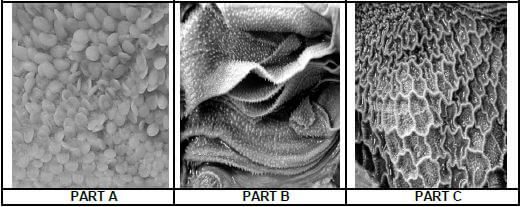
2.1.1 Identify part B and part C. (2)
2.1.2 Briefly describe ONE function of part B. (1)
2.1.3 Name the structures in part A responsible for the production of heat. (1)
2.1.4 State ONE requirement of rumen microbes. (1)
2.2 In a feed trial, an animal was fed 12 kg of hay with a moisture content of 10% and it excreted 7 kg of dry manure.
2.2.1 Calculate the digestibility coefficient of this hay. (Use a formula and show ALL calculations.) (5)
2.2.2 Briefly describe the implication of the calculated digestibility coefficient in QUESTION 2.2.1. (1)
2.2.3 Classify the feed used in the feeding trial above. (1)
2.3 The table below shows the nutritional composition of two feeds.
NUTRIENT COMPOSITION | FEED A | FEED B |
Total digestible nutrients (TDN) | 80% | 55% |
Digestible protein | 18% | 5% |
Nutritive ratio (NR) | 1 : 3,4 | 1 : 10 |
Crude fibre content | 9% | 17% |
2.3.1 Identify the feed (A or B) that will be the most suitable for young growing farm animals. (1)
2.3.2 Give a reason for the answer to QUESTION 2.3.1. (1)
2.3.3 Feed B cannot be recommended as a main feed for non-ruminants. Justify the statement by using the data above. (2)
2.3.4 Briefly explain the relationship between the crude fibre content and the total digestible nutrient of feed A. (2)
2.4 The table below shows the gross energy value and the energy losses after 1 kg and 5 kg of a feed were consumed by a farm animal.
ENERGY | VALUES (joule/1 kg) | VALUES (joule/5 kg) |
Gross energy | 18,5 | 92,5 |
Energy lost in manure | 8,5 | 42,5 |
Energy lost in urine | 1,2 | 6 |
Energy lost as heat | 1,8 | 9 |
Energy lost as methane | 2,5 | 12,5 |
2.4.1 Indicate the energy lost in manure if the farm animal consumed 5 kg of feed. (1)
2.4.2 Identify the gas with the highest energy loss in the table above. (1)
2.4.3 Calculate the amount of energy that will be available for growth and production in 1 kg of feed. (3)
2.5 The feed flow programme below is for a period of one year.
JUL. | AUG. | SEP. | OCT. | NOV. | DEC. | JAN. | FEB. | MAR. | APR. | MAY | JUN. | |
Veld (ton) | - | - | - | 10 | 12 | 20 | 20 | 15 | 13 | 12 | - | - |
Forage (ton) | - | - | - | - | 30 | 30 | 38 | 39 | 43 | 44 | 44 | - |
Lucerne (ton) | 40 | 45 | 55 | 45 | 30 | 25 | 20 | 10 | - | - | 10 | 30 |
Total feed available (ton) | 40 | 45 | 55 | 55 | 72 | 75 | 78 | 64 | 56 | 56 | 54 | 30 |
Animal feed requirement (ton) | 63 | 65 | 66 | 60 | 56 | 56 | 49 | 49 | 49 | 49 | 54 | 59 |
Feed deficit (ton) | 23 | 20 | - | 5 | 29 | |||||||
Feed surplus (ton) | 16 | 19 | 29 | 15 | 7 | 7 | - |
2.5.1 Calculate the feed deficit for September. (2)
2.5.2 Draw a bar graph to indicate the total feed available and the animal feed requirements for the year. (6)
2.6 Different ways of supplementing animal nutrients Give ONE word/term for each of the following descriptions by choosing a word(s) from the list below. Write only the word(s) next to the question numbers (2.6.1 to 2.6.4) in the ANSWER BOOK.
licks; soil sods; urea; implants; |
2.6.1 Iron supplement for pigs in concrete floor pens (1)
2.6.2 Cheapest protein supplement in ruminant rations during winter (1)
2.6.3 Growth-promoting hormones to increase the rate of feed conversion (1)
2.6.4 Supplementation of water-soluble vitamins (1) [35]
QUESTION 3: ANIMAL PRODUCTION, PROTECTION AND CONTROL
Start this question on a NEW page.
3.1 The pictures below show animal production systems. 
3.1.1 Identify production system A and production system B above. (2)
3.1.2 Compare production system A and production system B with reference to capital investment. (2)
3.2 The table below shows the feeding programme used to increase broiler production.
GROWTH STAGE | NUTRITIONAL REQUIREMENTS |
A. Day-old chick | High in protein |
B. 3- to 4-week-old chickens | Diet with a high percentage of energy |
3.2.1 Compare the nutritional requirements of broilers in growth stage A and growth stage B. (2)
3.2.2 Give a reason for the nutritional requirement in growth stage A. (1)
3.2.3 Name TWO other factors to increase production in broilers, except nutritional requirements. (2)
3.3 The photograph below shows a housing facility for breeding pigs. 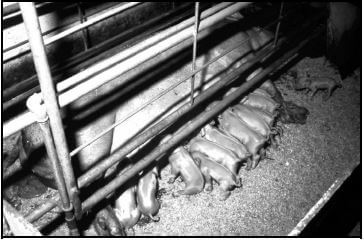
3.3.1 Identify the facility in the photograph above. (1)
3.3.2 State a design feature of the facility in QUESTION 3.3.1 that will prevent the piglets from being hurt. (1)
3.3.3 Name the equipment or material, except for roofing, that can be used in the facility above: (1)
- Provide heat for the piglets (1)
- Isolate cold cement floors (1)
3.4
In adverse weather conditions, livestock productivity in an extensive production system is inefficient in relation to the quantity of feed consumed. Animals experiencing excessively hot or cold conditions require more energy to maintain their basic metabolism, thus they have less energy available to increase their body weight or production. |
3.4.1 Identify the key condition that impacts negatively on production in the scenario above. (1)
3.4.2 Briefly describe TWO economic impacts of this condition on the farmer. (2)
3.4.3 Name a measure a farmer can take to reduce the impact of varying temperatures in an extensive cattle production system under:
- Hot conditions (1)
- Cold conditions (1)
3.5 The photographs below show animal handling facilities in an intensive production system. 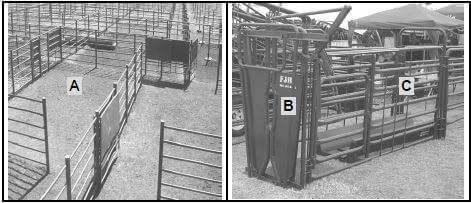
3.5.1 Identify handling facility A and handling facility C. (2)
3.5.2 Give the main purpose of structure B that is attached to handling facility C. (1)
3.5.3 Name TWO design features of handling facility C for the proper handling of farm animals. (2)
3.6 The table below shows information regarding the types of diseases in farm animals.
DISEASE | CAUSED BY | MODE OF TRANSMISSION | SYMPTOMS |
A | virus | B | excited, aggressive and excessive salivation |
tuberculosis | C | direct contact | respiratory distress |
D | protozoa | E | urine is dark red/brown |
ringworm | fungi | direct contact | F |
Refer to the table above and identify A, B, C, D, E and F. Do NOT copy the table. (6)
3.7 The diagram below represents the life cycle of a parasite in farm animals. 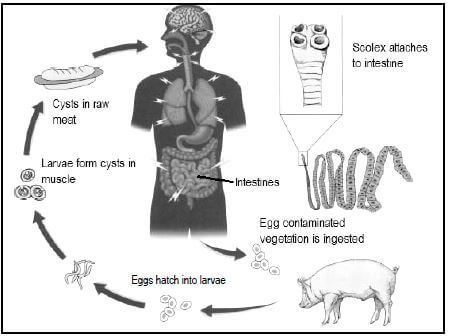
3.7.1 Identify the parasite in the diagram above. (1)
3.7.2 Indicate the number of hosts needed by the parasite in QUESTION 3.7.1 to complete its life cycle. (1)
3.7.3 State TWO economic implications of this parasite for farmers. (2)
3.7.4 State TWO roles of the state to control the spread of the internal parasites. (2) [35]
QUESTION 4: ANIMAL REPRODUCTION
Start this question on a NEW page.
4.1 The diagram below represents the male reproductive system of a bull. 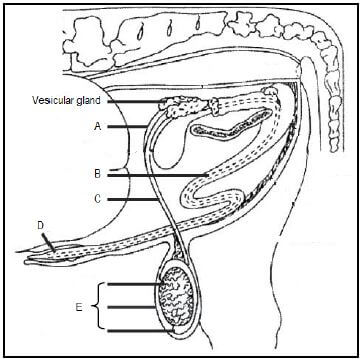
4.1.1 Identify part A and part B. (2)
4.1.2 State TWO functions of the secretion of the vesicular gland. (2)
4.1.3 Name a congenital defect of part D that can lead to an inability to service cows. (1)
4.1.4 Identify the effect on the fertility of the bull if part E is:
- Hanging very close to the body at all times due to a shorter scrotum (1)
- Totally removed (1)
4.2 The schematic representation below indicates the sequence of hormone levels resulting in changes that occur during the oestrus cycle as well as some structures involved. 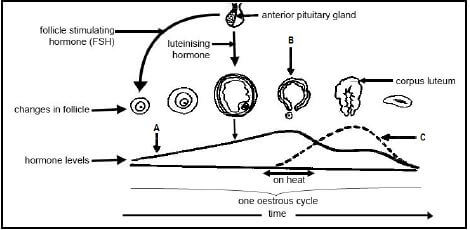
4.2.1 Identify hormone A and hormone C. (2)
4.2.2 Explain the process at B. (2)
4.2.3 Briefly describe TWO visible signs that the cow will display when hormone A is at its peak. (2)
4.2.4 State the main function of FSH in the schematic representation above. (1)
4.3 The data below shows reproductive processes in sheep.
- Artificial insemination (AI)
- Lambing
- Synchronisation of oestrus
- Conception
- Pregnancy
4.3.1 Arrange the processes above in the correct chronological order. Write down only the letters (A–E) next to the question number (4.3.1) in the ANSWER BOOK. (5)
4.3.2 Define the term synchronisation of oestrus. (2)
4.4 The diagram below is a schematic representation of the reproductive cycle of a dairy cow. 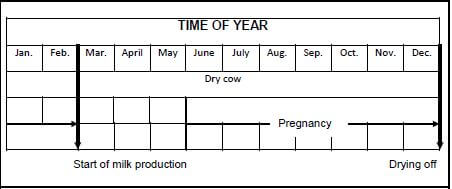
4.4.1 Identify the month in which artificial insemination should take place for this dairy cow. (1)
4.4.2 Name TWO possible causes why the cow may not conceive after insemination. (2)
4.4.3 State THREE causes of abortion in dairy cows. (3)
4.4.4 Name the last reproductive process just before the start of milk production in this dairy cow. (1)
4.5 The graph below illustrates a dairy cow's average milk production, as well as the fat and crude fibre content of the milk over a period of 10 months. 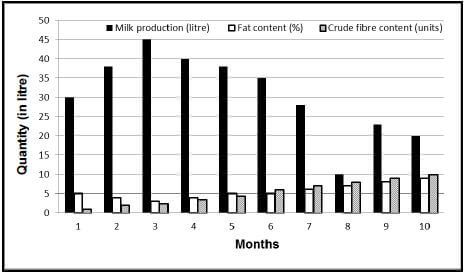
4.5.1 Indicate the month when an average of 35 litres of milk was produced. (1)
4.5.2 Identify the quantity of milk produced during the peak month of lactation. (1)
4.5.3 Give THREE possible reasons for the drop in milk production in MONTH 8. (3)
4.5.4 Describe the relationship between the crude fibre and the fat content of milk from MONTH 6 to MONTH 10, as illustrated in the graph above. (2) [35]
TOTAL SECTION B: 105
GRAND TOTAL: 150